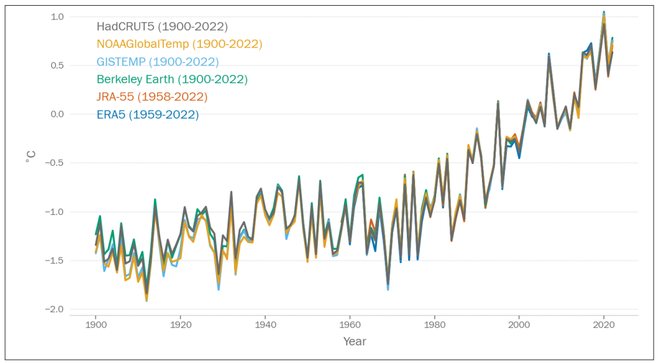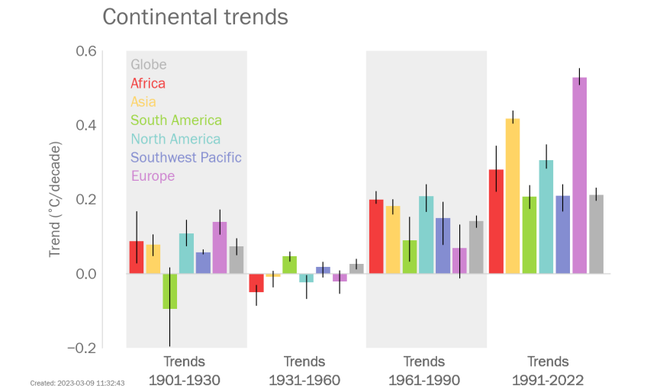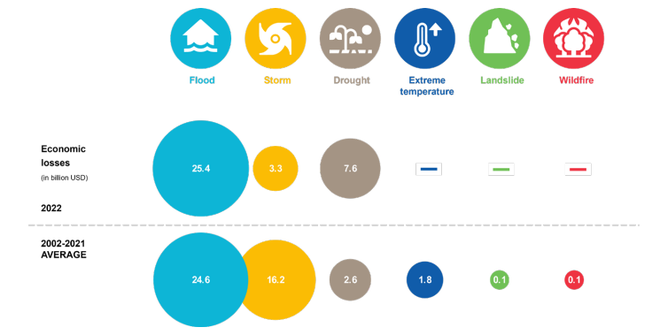The story so far: Drought, floods, and high temperatures were the critical disasters that plagued Asiain 2022, causing extensive damage to life and property. In its 2022 State of the Climate in Asia report, the World Meteorological Organisation (WMO) summarised extreme climate events taking place in Asia last year, and their socioeconomic impact.
The report was prepared in collaboration with the National Meteorological and Hydrological Services (NMHSs), research institutions, and agencies of the United Nations.
Global climate
Globally, the annual mean near-surface temperature in 2022 was 1.15 °C above the 1850–1900 pre-industrial average. Ocean heat content, the total amount of heat stored by the oceans, was the highest on record in 2022. Global mean sea level too reached a new high in 2022 on account of ocean warming and accelerated loss of mass from ice sheets.
Key findings
According to the report, 2022 was the second or third warmest year on record. Temperatures touched new highs, glaciers melted at incredible speeds, and Asia, and the world in general, raced even further towards a point of no return.
Temperature
In 2022, mean surface temperature was either the second or third highest on record – 0.73 °C above the 1991–2020 average (reference period used for computing anomalies in temperature and other indicators) and 1.6°C above the 1961–1990 average (WMO reference period for assessing long-term climate change).
Northern Siberia, northern West Asia, Central Asia, and western and coastal areas of China noted above average temperatures in 2022. The year was also the second warmest year on record for China overall.

Research also shows that a warming trend emerged in Asia in the latter half of the twentieth century. This trend in 1991–2022 was almost double the warming trend during the 1961–1990 period, and much larger than the trends of the previous 30-year periods.

The area-averaged sea surface temperature anomalies in 2022 were the warmest on record in the northwest Pacific Ocean, and were below the record value reached in 2020 in the Indian Ocean. Further, the Barents Sea in the Arctic Ocean has been identified as a climate change hotspot.
Precipitation
Parts of Iraq, the Hindu Kush (the high mountain range stretching from central to western Afghanistan), the lower course of the Ganges and Brahmaputra Rivers (India and Bangladesh), the Korean Peninsula, and Kyushu (the western island of Japan) observed the largest precipitation deficits in Asia in 2022. Central Asia, the Yangtze River Basin (where a severe drought was reported) and the Huaihe River Basin in China, southwest and northwest Asia, and areas along the Arctic coast also recorded precipitation below normal.
On the other hand, south Pakistan, southeast Asia, and northeast China received excessive precipitation in 2022. Siberia, northeast Asia, central India, India’s Western Ghats, eastern Himalayas (Nepal and Bhutan), and areas along north China’s Yellow River and western Tian Shan (high mountain range in western China) recorded unusually high precipitation.
India’s Western Ghats and Khasi Hills, and areas along the coast of the South China Sea and East China Sea recorded the highest daily precipitation totals in 2022. Positive anomalies with respect to the highest daily precipitation totals were also detected in parts of Iran and Iraq. This shows that extreme precipitation events can also occur even if the annual total is below normal.
Glaciers
Preliminary data shows that in the glaciological year 2021-22, 23 glaciers in the High Mountain Asia region showed continued reduction in their masses. In the 2021-22 period, Urumqi Glacier No. 1 in eastern Tien Shan recorded its second most negative mass balance since measurements began in 1959.

Extreme events: Cyclones
In 2022, 25 named tropical cyclones with maximum sustained wind speeds of 34 knots or more formed over the western North Pacific Ocean and the South China Sea. Nanmadol typhoon, which made landfall in Japan’s Kyushu region on September 18, 2022, was the strongest tropical cyclone of the year. Almost four million people were told to evacuate, while it reportedly affected 1,300 people, killed five, and caused economic damage worth more than US$2 billion.
Three tropical cyclones, and 15 cyclonic disturbances (where wind speed was greater than 27 knots) formed over the north Indian Ocean in 2022.
Floods
Pakistan witnessed severe floods in the 2022 monsoon season between June and September. According to authorities, almost 14% of the country’s population was displaced as a result of the floods, while 1,730 people died and around eight million were displaced. The floods destroyed 1.7 million hectares of agricultural land, forcing millions towards poverty and food insecurity.
Heavy monsoon especially affected Northeast India, as well as neighbouring Bangladesh where the floods cumulatively killed 2,000 people and affected 1.3 million people. This was the worst natural disaster affecting India in 2022.
Droughts
Yangtze River basin in southwest China, home to a third of China’s population, experienced its worst drought in six decades in the summer of 2022. An intense heatwave in central-eastern China, along with moderate precipitation deficit, caused the drought.
The water from the Yangtze River is used for crop irrigation, transportation and energy production, and the domino effect from the drought impacted everything. The Three Gorges Dam, the largest hydropower plant in the world, is also located along the Yangtze River. The approximate economic loss from droughts in China in 2022 amounted to US$ 7.6 billion.
Iran was another Asian country adversely impacted by drought in 2022, its third consecutive year of drought. The surface area of Lake Urmia, which has shrunk by 95% over the past three decades, continued to decrease in 2022.
Other extreme events in India
India and Pakistan experienced unusually warm conditions in the pre-monsoon season, between March and May. Further, lightning, accompanied by thunderstorms, has become one of the biggest killers in India in the recent years. In May 2022, more than 34 people killed due to lightning in Bihar.
Impact on the economy
Economic losses caused by floods in 2022 exceeded the average observed over the past 20 years. The most significant losses were seen in Pakistan (over US$ 15 billion), China (over US$ 5 billion) and India (over US$ 4.2 billion).

Economic damages associated with drought in Asia were noted to be around US$ 7.6 billion in 2022. For other disasters, the economic damage was milder. In the case of storms in particular, Asia lost around US $3.3 billion, which was almost 80% lower than the 2002–2021 average of US$ 16.2 billion.







